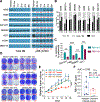Retinoblastoma Expression and Targeting by CDK4/6 Inhibitors in Small Cell Lung Cancer
- PMID: 36399634
- PMCID: PMC9898162
- DOI: 10.1158/1535-7163.MCT-22-0365
Retinoblastoma Expression and Targeting by CDK4/6 Inhibitors in Small Cell Lung Cancer
Abstract
The canonical model of "small cell lung cancer" (SCLC) depicts tumors arising from dual inactivation of TP53 and RB1. However, many genomic studies have persistently identified tumors with no RB1 mutations. Here, we examined RB1 protein expression and function in SCLC. RB1 expression was examined by IHC analysis of 62 human SCLC tumors. These studies showed that ∼14% of SCLC tumors expressed abundant RB1 protein, which is associated with neuroendocrine gene expression and is enriched in YAP1 expression, but no other lineage proteins that stratify SCLC. SCLC cells and xenograft tumors with RB1 protein expression were sensitive to growth inhibition by the CDK4/6 inhibitor palbociclib, and this inhibition was shown to be dependent on RB1 expression by CRISPR knockout. Furthermore, a patient with biopsy-validated wild-type RB1 SCLC who received the CDK4/6 inhibitor abemaciclib demonstrated a dramatic decrease in mutant TP53 ctDNA allelic fraction from 62.1% to 0.4% and decreased tumor mass on CT scans. Importantly, IHC of the diagnostic biopsy specimen showed RB1 positivity. Finally, we identified a transcriptomics-based RB1 loss-of-function signature that discriminates between SCLC cells with or without RB1 protein expression and validated it in the patient who was responsive to abemaciclib, suggesting its potential use to predict CDK4/6 inhibitor response in patients with SCLC. Our study demonstrates that RB1 protein is an actionable target in a subgroup of SCLC, a cancer that exhibits no currently targetable mutations.
©2022 American Association for Cancer Research.
Conflict of interest statement
Figures




References
Publication types
MeSH terms
Substances
Grants and funding
LinkOut - more resources
Full Text Sources
Medical
Molecular Biology Databases
Research Materials
Miscellaneous

